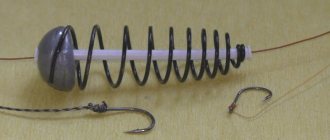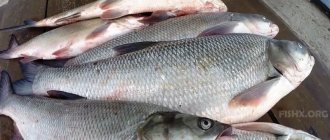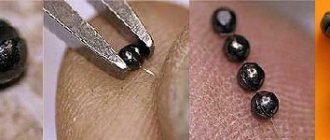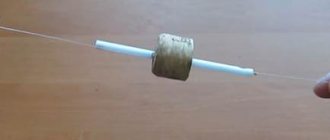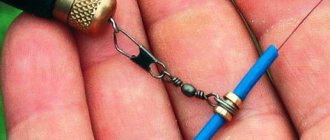Which float is best for winter fishing
In stores and on the Internet, you can find a large number of floats for winter fishing, the range is similar to summer gear, and you need to choose them by studying the intricacies. For winter, gear should be selected more carefully, and the fishing rod should be set up correctly.
When choosing, the secondary factors are shape, color and size. This is due to the fact that the float does not need to be cast far, so it may not be multi-colored. All actions take place in the hole, in the immediate vicinity of the fisherman. It is much more important to determine the load capacity and features of the products. The main task of the element is to unload the mass of bait and equipment. The greater the sensitivity of the gear, the easier it is to detect a bite.
Important! The calmer the water, the thicker the float is needed.
Forms
All floats for fishing in winter are often small in size and made of foam or balsa. They vary in shape; during fishing during this period, there are no summer factors, including winds or distance from the main location of the fisherman. The float needs to be immersed only 2–5 cm.
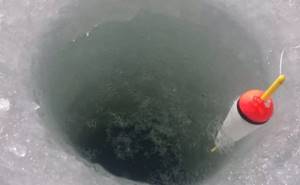
Among the main types according to shape are:
- Round or cylindrical.
- Models are cylindrical with a beveled top.
- Double.
- Winter model "tablet".
- Petals opening.
- Flowers, roses.
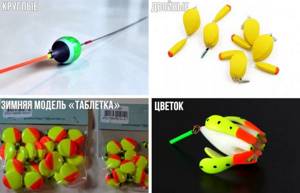
Often 1–2 types are used, as well as ovoid models. The last pair of models are rarely used, and the product itself is considered exotic.
If you set up the fishing rod correctly, there won’t be a big difference in the floats, and the choice depends on the price and personal preferences. For example, a “tablet” is better visible during ascent; at night, a drop of paint or varnish with the addition of phosphorus can be applied to the equipment. When fishing, it is not the shape that is more important, but the type of fastener to the fishing line.
Did you know? The longest fight with fish reached 32 hours. A black marlin weighing more than 600 kg pulled the boat for 80 km weighing 12 tons, after which the fishing line broke.
Attachment to fishing line
According to the type of fastening, all options are divided into removable and non-removable models. The latter option is rarely used, since you need to pass the line through the entire float to attach it. Replacement is carried out exclusively together with the equipment. The removable version is attached to the fishing line at a certain point through a cambric or a special tube. It is fixed by a metal or plastic pin at the bottom of the float.
Considering all possible fastening options, we can highlight:
- Through - performed in the center through a hole (non-removable type).
- Cambric or through a tube - a universal version of removable equipment, makes it possible to install other signal elements without dressings. Only the cambric is attached to the fishing line.
- With a side slot on the float - the fishing line is inserted into a special slot and clamped with a pin. The part can be replaced, excluding bandaging.
- Through a crooked hole in the float - a rare type of fastening. Winter fishing rods should be simple and reliable; this type of fixation has difficulties, which include the passage of fishing line.
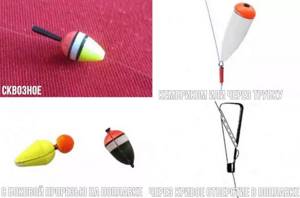
Long casts in winter are irrelevant, so not the strongest, but reliable mount will do. Even if the float comes off, it will remain on the water in the hole.
Important! The most sensitive floats
—
with a relatively thin and elongated main part.
Varieties
Floats for winter fishing with petals are made according to the principle of composite structures. The petals are hingedly attached to the main body; when floating up, they spread out to the sides on the surface of the water in the hole, which gives such an interesting visual effect.
Petal
The float petal has the right to life from the point of view of practicality. This is an ordinary composite float, the upper part of which is made in a shape that allows it to beautifully unfold on the surface, from the center of the axis to the side. It has only one petal, which does not particularly interfere with the fishing process when removing the fishing line from the ice back into the hole. There is also a practical benefit to this design. The overall length of the float is longer than that of a regular float. This means that the amplitude at which the weight of the bait in the fish’s mouth decreases (taken by the pop-up float) is greater. You can read more about this in the article on winter rigging fishing rods for bream. When catching this fish, it is important that it does not feel the weight of the jig in its mouth when biting.
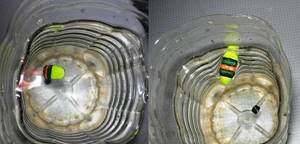
Trousers
This design presupposes the presence of two parts, spreading to the sides when lifted. Because of its unique appearance, the float is popularly called “pants”. The two floating petals are even more noticeable in the hole. But the overall design is more complicated, and you need to handle such a fishing rod more carefully, preventing the petals from freezing to the ice.
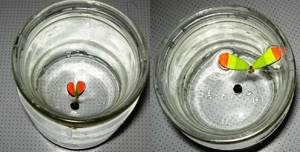
Flower
A true masterpiece of ice float fishing. The flower float for winter fishing is beautiful, complex and difficult to use, especially when fishing in the cold. You should not allow it to get on wet ice - the petals will instantly freeze, and when you try to separate them from the ice, they will probably come off or break. A fishing rod with a flower is comfortable to use during a thaw or in a tent with a bottom. The flower adds effective visualization of the bite and difficulty when working with the tackle. The expediency of its use is based not on practicality, but on the fisherman’s emotional craving for beauty.
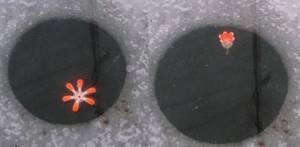
Composite floats
Such models are ideal for catching fish from the depths of reservoirs, when using a sensitive fishing rod with a large mass of bait or weights. Classic models in the form of a ball or an egg do not provide the necessary sensitivity, so you may not have time to hook. It is recommended to use composite models in winter if you plan to catch crucian carp or bream from the bottom of the reservoir. Fastening is carried out through a cambric or pin. Products come in double, triple, etc.
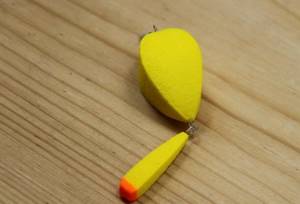
Flowers, roses, daisies
Classic float models use compensation for fishing, while the devices described have a more artistic purpose. Some fishermen prefer to use a flower, roses or daisies, which will bloom beautifully during the bite and when lifting the fishing rod. For example, daisies or tulips are beautiful for winter fishing, but there are several disadvantages. They use many components, small parts on a hinge mechanism that can be easily damaged. They quickly freeze and come off, so you need to use them carefully.
Did you know? The man-eating white shark is the largest prey caught on line. Its mass
-
1200 kg and length
-
5.13 m.
In terms of functionality, there will not be much difference from standard devices. The flowers are brightly displayed during the ascent and can partially compensate for the weight of the bait.
Winter fishing rod equipment
The main equipment is the float. A hook or jig and weights on a fishing line are also used. It is formed based on conditions, or rather the depth of the river and current.
The main equipment options include:
- with hook;
- with jig;
- combined with a hook and 1–2 jigs.
The main parts are attached without leashes, the auxiliary hook is knitted above the main one through the leash. The jig can be used as a load, so it is fixed higher than other parts.
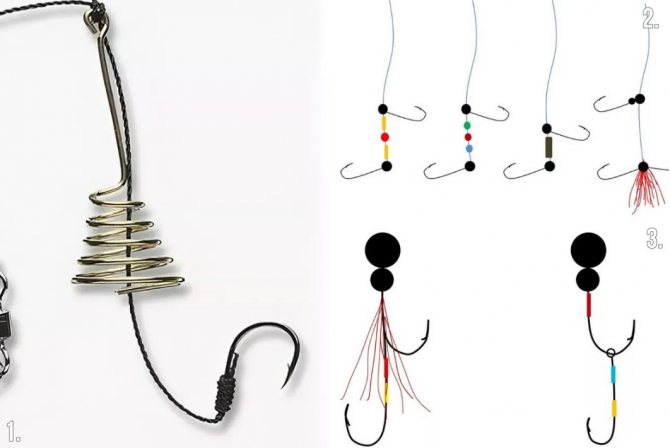
fishing line
Fishing in cold weather requires precise selection of fishing line. Many information materials indicate that it is 0.14 mm in diameter and thicker. The size is needed so that it can take the load if bream or crucian carp bites. However, such advice is incorrect. If you plan to catch large fish, then you need to use a fishing line with a diameter of 0.13–0.15 mm; for roach, silver bream and other small prey, 0.1–0.12 mm is enough. Options above 0.14mm are used for really big production.
Important! The main characteristics of the float for crucian carp
—
thickness of the tip.
When a fish takes the bait, there is a risk that it will feel resistance and immediately refuse to eat, so you need to use the thinnest tip possible. For winter fishing enthusiasts, it is recommended to buy several fishing rods with fishing line of different thicknesses. This rule is also justified by the fact that fishermen make several holes at once for fishing, due to which the equipment can be quickly tested.

Loading
The winter float does not use an antenna, since there is no need for it. The inspection is done not from the side, but from above, in close proximity. The element itself is completely immersed in water to prevent it from freezing or growing into an ice film. The float is immersed to a depth of up to 5 cm. The weight of the weights and jigs should give just such a load. Correct and precise adjustment is carried out by selecting the mass of weights.
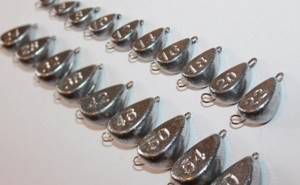
For ease of fishing, it is recommended to buy fishing rods that can be installed on ice . For this purpose, special stands or “Filly” devices are used. You can discard the coil or use any type of coil.
DIY winter float

Making a winter float with your own hands is not difficult. You only need desire, a little time and hard foam with tools - a sharp knife, file or sandpaper. Making a float for winter fishing is even easier than the correct nod. If you do not have the necessary materials, you can modify the store float.
The process of making a winter float was well demonstrated by Dmitry Salapin in his video:
How to make a winter float:
- From a piece of hard foam we cut off the blank for the future winter float;
- Using a knife, we form a cylindrical shape of the float with a transition to a cone at the bottom;
- We make two loops from a single-core telephone wire, one of which is glued into the lower base of the float, and the other is suspended from it using the loop-to-loop method - this is the mount that secures the float to the fishing line;
- We paint the float with a permanent marker, varnish or paint.
A cylindrical winter float made of polystyrene foam can be compacted by rolling it between two planks. At the same time, the surface of the float becomes more even and smooth, and the small pores of the foam close.
The upper part of the float is cut obliquely so that during a bite on the surface, the float goes to the side - this way the bite is better visible.
Painting the float is useful not only for better visualization of the bite, but also so that the float freezes less and is easier to free from frozen ice.
The best baits and lures
Among the best natural baits are:
- bloodworm;
- maggot;
- light larvae;
- bark beetle
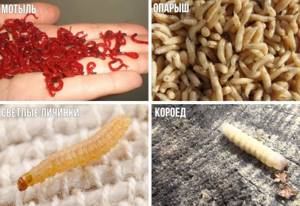
The most popular among fishermen is a bunch of bloodworms. However, when it is pierced with a hook, the color becomes pale and the contents flow out. To exclude this, bundles of 4–7 pieces are prepared in advance. bloodworms. They are tied with nylon thread, and the finished baits are stored in match boxes for easy storage and use while fishing. Threading is done by prying the thread, but so that the hook remains invisible. To solve this problem, 1 bloodworm is put on it.
For a big catch, it is important to use the right bait. Therefore, immediately after drilling holes, you need to pour fish food into the cone container. It is good to do this procedure 1–2 days before the start of fishing. Suitable pea or semolina porridge, which are crushed and mixed. The use of seeds, crackers, and pearl barley is also allowed. You can use porridge only before fishing.
Did you know? Carp
—
It is a smart and cunning fish, so it can only be caught through complementary feeding, which begins in the fall. A light jig is used for fishing.
The process of fishing with a winter fishing rod
The whole procedure of winter fishing is significantly different from that which is performed in summer or spring.
The main stages are identified:
- Drilling a hole. An ice ax is used to drill holes in the ice. The place is chosen where the required fish is located. To avoid interference with the float, you should remove the fine crust from the surface with a scoop and repeat the steps from time to time when fishing. Be sure to drill in the center and perpendicular to the current, otherwise there will be no good catch. Beginners often make holes with the current, and then the bait is carried away.
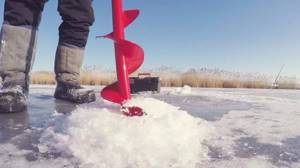
- Loading the float. A minimum of 2 pellets are used, the smaller one is placed 5–7 cm below the hook. This results in a slow sinking of food for the fish, and the prey itself reacts more actively to the bait.
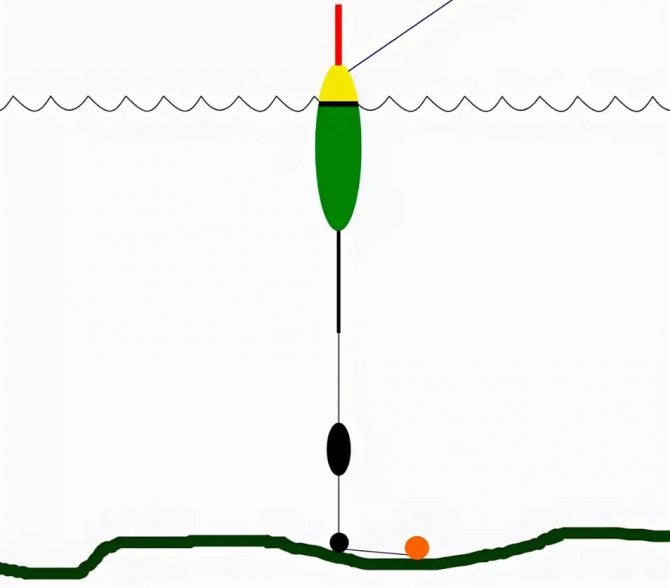
- Bite. Having immersed the float, you just have to wait: as soon as it emerges or goes to the side, the hook is performed. To do this, the fishing line is held and pulled, the fishing rod is placed on the ice, and careful fishing is performed without sudden movements so that the prey does not break the fishing line and tackle.
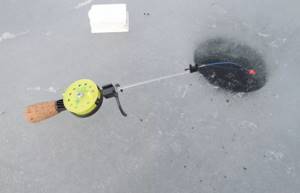
Having taken out the fish, they change the bait, repeat the fishing procedure, but you need to lower the hook while wearing a glove, and clench your fingers into a fist to break through the ice crust.
When choosing a float, you need to pay attention to its main characteristics. It should not be slippery and should be made from a material that does not absorb water. It is better to focus on models with full color and varnish. Winter fishing has many advantages, because you don’t have to hold fishing rods in your hands, and the process is carried out from several holes at once, which helps to increase your catch. For a high-quality and effective lesson, you need to choose the right float and know a few subtleties described above.
Pop-up float for ice fishing
This post provides the basics for creating pop-up floats. The device is useful for anglers who are interested in ice fishing.
In winter, float gear is used mainly for catching bream, silver bream, and bream.
See what you need to prepare to create a self-expanding float. 1. Dense foam. 2. Insulated wire. 3. Cambric. 4. Reflective paint. 5. Waterproof glue.
Browse products for inventors. Link to the store.
We will need some tools. 1. Pocket knife. 2. Hacksaw for metal. 3. Pliers. 4. Shilo. 5. Ruler. 6. Sandpaper.
As you can easily guess from the title of the articles, the float proposed for production is capable of opening when bitten. This is possible by the design of the device, which consists of two identical halves in the shape of a cone. The two parts are connected by a loop made from a piece of insulated copper wire.
Next, the float is painted with reflective paint. Its color depends on your preferences. After this, the fishing line is threaded with the cambric installed on it. It will slide freely. A depth gauge will be installed. The next step is to conduct tests in a deep bowl of water. You need to load the tackle so that the float is immersed in the water. Otherwise, it will freeze and become overgrown with ice. Without this condition, you will not be able to fish normally.
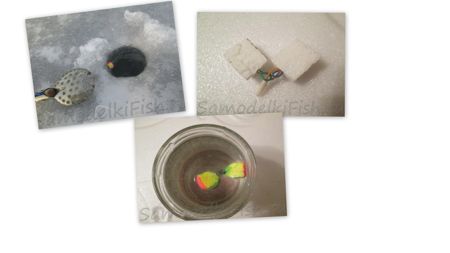
Let's return to making tackle. First of all, let's make a cone. This cone must be divided into two equal sides. Use sandpaper to smooth out uneven surfaces. We take the wire and make loops that will be located at the bottom of the float. A small depression is made in each piece of polystyrene foam, each loop is smeared with glue and installed in this hole. The rings must be combined with a pre-prepared loop with a cambric. In the future, a fishing line with a depth gauge will be attached to it.
The gear is almost ready. Now you can carry out testing and shipment of the float. To do this, throw the workpiece into a container filled with water. Our task at this stage is to make sure that the float does not swing on the surface of the water, but is immersed in it. In the photo we can see that the float has opened slightly, but the main part of it is under water.
Now that the test study has been completed and the float has been shipped correctly, you can begin painting the product. Naturally, it is advisable to paint it in a bright color for better visibility, given that the opening float will be slightly hidden by water.
It's not over yet. You need to use the container again to check how the tackle will react to a bite. You can fish with a bottle.
Materials: samodelkifish.ru



